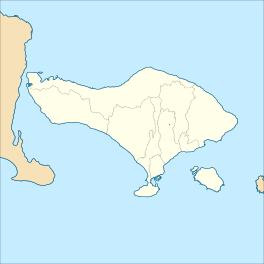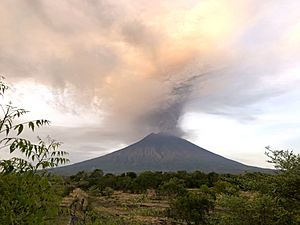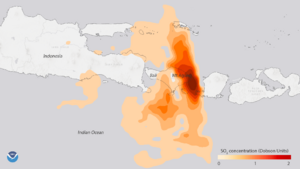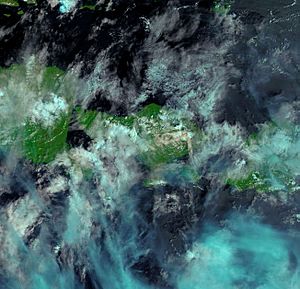2017–2019 eruptions of Mount Agung facts for kids
Quick facts for kids 2017–2019 eruptions of Mount Agung |
|
|---|---|
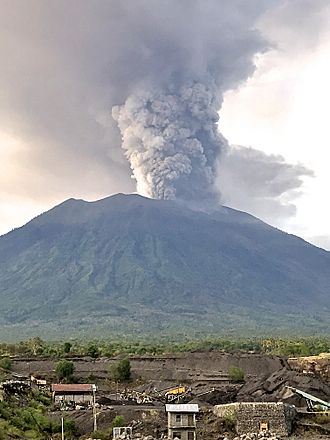
Mount Agung on 27 November 2017
|
|
| Volcano | Mount Agung |
| Type | Vulcanian/Sub-plinian |
| Location | Bali, Indonesia 8°20′35″S 115°30′25″E / 8.34306°S 115.50694°E |
| VEI | 3 |
Mount Agung is a large volcano on the island of Bali in Indonesia. From late 2017 to mid-2019, it erupted many times. These eruptions caused thousands of people to leave their homes. They also stopped air travel and harmed the environment.
Scientists noticed small earthquakes from the volcano starting in August 2017. The volcano became more active for several weeks. Then, it quieted down in late October. A second, stronger period of activity began in late November. Mount Agung also erupted in 2018 and 2019.
Contents
About Mount Agung
Past Eruptions: 1843
Mount Agung erupted in 1843. A scientist named Heinrich Zollinger wrote about it. He said the mountain had been quiet for a long time. Then, it started to become active again. First, there were earthquakes. After that, the volcano sent out ash, sand, and stones.
Past Eruptions: 1963
The 1963 eruption of Mount Agung was one of the worst in Indonesia's history. It began on February 18, 1963. Hot lava started to flow down the mountain on February 24. It traveled about 7 kilometers (4.3 miles) over three weeks.
On March 17, a very powerful eruption happened. It was a VEI (Volcanic Explosivity Index) of 5. This means it was a very big explosion. Fast-moving clouds of hot gas and ash, called pyroclastic flows, rushed down the mountain. They killed at least 1,500 people.
Later, heavy rain mixed with ash. This created mudflows called lahars. These mudflows killed about 200 more people. Another smaller eruption happened on May 16. It also sent pyroclastic flows down the mountain, killing about 200 more. By early 1964, about 1,900 people had died. This made it the 8th deadliest volcanic eruption of the 20th century.
Since 1963, the number of people living in Bali has almost doubled. Because of this, Indonesian authorities see Mount Agung as very dangerous. This is why they decided to move over 100,000 people to safety in 2017. They did this when the volcano started to show signs of activity.
Mount Agung's Activity in 2017
August 2017
Scientists saw volcanic earthquakes starting on August 10, 2017. The earthquakes became stronger in the weeks that followed.
September 2017
On September 30, 2017, the volcano rumbled more often. The earthquakes also increased. This made officials raise the alert level to the highest point. About 122,500 people living near the volcano were moved to safety.
The Indonesian National Board for Disaster Management set up a danger zone. This zone was 12 kilometers (7.5 miles) around the volcano. A cloud of ash was seen on September 13. People who left their homes stayed in sports halls and other community buildings. These places were in areas like Klungkung and Karangasem Regency.
On September 25, the area had 844 volcanic earthquakes. By midday on September 26, there were 300 to 400 more. Scientists were worried about how strong and often these earthquakes were. Similar volcanoes had erupted with much less activity.
October 2017
In late October 2017, the volcano's activity slowed down a lot. Because of this, the alert level was lowered on October 29. The alert level stayed at 3 (out of 4) until the next period of major activity began. During this time, small plumes of gas were still seen.
November 2017
November 21
A small phreatic eruption happened at 9:05 AM UTC on November 21. A phreatic eruption happens when hot water or steam explodes. The top of the ash cloud reached 3,842 meters (12,605 feet) above sea level. Thousands of people quickly left the area. Over 29,000 people found temporary shelter in more than 270 places nearby.
November 25
A magmatic eruption started early on Saturday, November 25. This means fresh magma reached the surface. The eruption plume rose 1.5 to 4 kilometers (0.9 to 2.5 miles) above the top of the volcano. It drifted south, covering the area with a thin layer of dark ash. Some airlines canceled flights to Australia and New Zealand. Later that night, an orange glow was seen around the crater. This confirmed that new magma had reached the surface.
November 26
Another eruption happened at 11:37 PM UTC on November 26. The Ngurah Rai International Airport was closed the next day. This left many tourists stuck. More than 100,000 people living within 10 kilometers (6.2 miles) of the volcano were told to leave.
November 27
The eruption from Sunday, November 26, continued steadily. Mudflows called lahars were reported in the Selat district south of the volcano. The Australian Bureau of Meteorology said the ash column reached 9,144 meters (30,000 feet) high. The ash kept spreading southeast. Experts thought that the ash in the air could affect up to 5.6 million people. This was because the area around the volcano is very crowded.
November 29
The eruption became less intense. The wind also spread the ash cloud away. Because of this, officials reopened Ngurah Rai International Airport at 7:00 AM UTC. However, authorities warned that the eruption could get stronger again. This might cause air traffic to stop once more.
Mount Agung's Activity in 2018
January 2018
The volcano erupted again on January 11. It sent out clouds of smoke and ash. Bali's international airport was declared safe and worked normally. The eruption column was reported to rise 2.5 kilometers (1.6 miles) above the mountain.
June 2018
Agung erupted on June 12. It sent plumes of smoke and ash about 2,000 meters (6,560 feet) above the volcano's top. No flights were affected by this event.
On June 28, water vapor and volcanic ash were seen coming from Mount Agung. They went up to 2 kilometers (1.2 miles) into the air. Ngurah Rai Airport was closed because of this.
July 2018
Agung erupted again on July 3. This was a small strombolian explosion. About 700 people living near the crater were moved to safety. No flights were affected.
December 2018
On the morning of December 30, the volcano sent ash into the sky. It erupted for about three minutes. White clouds of smoke and ash went more than 700 meters (2,300 feet) into the air. Several villages in Bali were covered in a thin layer of ash. However, no smoke or lava was seen coming from the volcano. No one was ordered to leave their homes.
Mount Agung's Activity in 2019
January 2019
Agung erupted on January 10. It produced columns of volcanic ash. The top of the volcano was covered by thick haze during the eruption. So, the exact height of the ash could not be seen.
February 2019
On February 22, a volcanic ash plume rose to an estimated 14,000 feet (4,267 meters) altitude. This is also known as flight level 140.
March 2019
Explosive activity continued on March 8, the day after Nyepi (a Balinese holiday). A volcanic ash plume rose to an estimated 12,000 feet (3,658 meters) altitude. This is flight level 120. It was moving at 10 knots (18.5 km/h or 11.5 mph) to the southeast.
Mount Agung erupted again on March 28. Bali's I Gusti Ngurah Rai International Airport worked normally. The air above the airport was clear of volcanic ash. This was confirmed by a special paper test.
April 2019
On April 3, 2019, a 2,000-meter (6,560-foot) high column of ash erupted from Agung. The Center for Volcanology and Geological Hazard Mitigation (PVMBG) kept the volcano's alert level at "stay on alert." This is the third level of a four-level system. The center also set the danger zone at a 4-kilometer (2.5-mile) radius from the crater.
May 2019
In late May 2019, an eruption sent lava and rocks about 3 kilometers (1.9 miles) away. Some ash fell on nearby villages. This temporarily stopped international flights.
June 2019
Another explosion happened at the volcano on June 13, 2019, at 1:38 AM local time. This was a Vulcanian eruption. It threw out glowing hot material at least 700 meters (2,300 feet) from the crater. It also created an ash plume that rose to 30,000 feet (9,144 meters) altitude. This plume drifted south over Denpasar.
According to PVMBG, the eruption lasted almost 10 minutes. This made it one of the longest in this series of Vulcanian explosions. A small group of earthquakes and a slight swelling of the volcano (called inflation) happened on June 12, 2019, before this eruption.
Impact of the Eruptions
The 2017 eruption caused about 40,000 people to leave their homes. These people were from 22 villages around Mount Agung. The eruptions also caused nearby airports to close.
Lombok International Airport, on the island of Lombok, closed on November 26. It reopened the next morning but closed again on November 30. Lombok's airport reopened on December 1. Ngurah Rai International Airport, in southern Bali, closed on November 27. More than 400 flights were canceled. About 59,000 passengers were stuck. The airport reopened on November 29. These eruptions also caused tourism in Bali to drop by about 30%.
See also
 In Spanish: Erupción del monte Agung de 2017 para niños
In Spanish: Erupción del monte Agung de 2017 para niños


